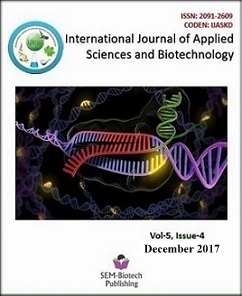Management of Purple Blotch Complex of Onion in Indian Punjab
DOI:
https://doi.org/10.3126/ijasbt.v5i4.18632Keywords:
Fungicides, Management, onion, purple blotch complex, Benefit, Cost ratio, triazoleAbstract
Six systemic fungicides viz., Kitazin 48 EC (iprobenfos), Tilt 25 EC (propiconazole), Folicur 25 EC (tebuconazole), Score 25 EC (difenoconazole), Amistar Top 325 SC (azoxystrobin 18.2% + difenoconazole 11.4%) and Nativo 75 WG (trifloxystrobin 25% + tebuconazole 50%), and two non-systemic fungicides viz., Indofil M-45 75 WP (mancozeb) and Kocide 77 WP (copper hydroxide), were evaluated under in vitro and field conditions for their efficacy to manage purple blotch complex of onion caused by Alternaria porri and Stemphylium vesicarium. Field efficacy of the fungicides at different concentrations were determined in controlling the purple blotch complex of onion under artificial epiphytotic conditions on bulb and seed crop (cultivar PRO-6) during the Rabi season 2014-2015 and 2015-2016, respectively. The triazole fungicides, tebuconazole and difenoconazole proved superior in inhibiting growth of A. porri and S. vesicarium under in vitro conditions, respectively. Further, foliar sprays (3 for bulb crop and 4 for seed crop) of tebuconazole 25 EC (Folicur) @ 0.1 per cent at fortnightly interval most effectively managed purple blotch complex of onion under field conditions with highest Benefit: Cost ratio (8.75:1 and 88.7:1) in bulb and seed crop, respectively. Seed-to-seed method of onion seed production recorded significantly lower disease severity and higher seed yield than that of bulb-to-seed method under natural epiphytotic conditions. The present findings can be instrumental in devising strategy for the integrated management of A. porri, S. vesicarium singly as well as in complex, serious limiting biotic factors in onion production.
Int. J. Appl. Sci. Biotechnol. Vol 5(4): 554-565




